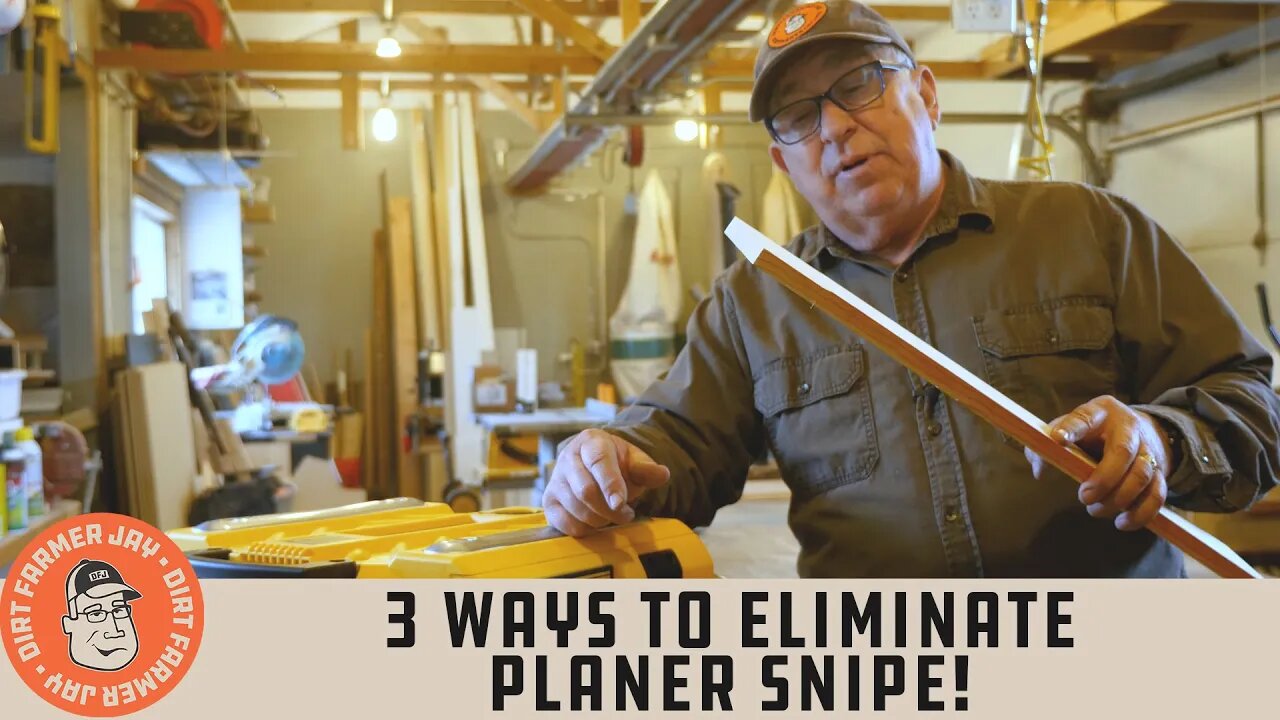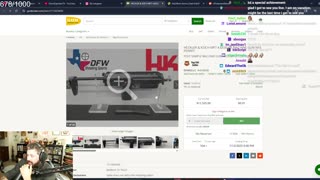Premium Only Content

3 Ways to Eliminate Planer Snipe!
A wood planer is a hardworking tool in the woodshop, but if the wood isn’t handled correctly when it enters and exits the machine, you can get “snipe” or a deeper cut on the ends. Eliminate that for good!
#woodplaner #planer #thicknessplaner
Buy your DFJ T-Shirt, Cap, or Coffee Mug at https://www.dirtfarmerjay.com/shop
No matter what type of wood thickness planer you have, snipe can occur. It doesn’t matter if you have a hobbyist model, mid-range, or professional machine, you can still end up with “snipe”, where a significant amount of the end of the board can be planed thinner than the target thickness. If the board isn’t cut oversized in the early stages of milling, the board may end up not being able to be used for what you planned. Not good.
What causes snipe, anyway? A planer works by pressing a flat side of the board against the “bed” of the planer, using a roller in front and behind the rotating knife head. So, as you feed a board into the machine, the board will lay on top of the bed, then advance under the first roller, encounter the planer knives, then the next roller. As the board exits the machine, the trailing end will come out from under the first roller but is still being thicknessed by the cutter knives. The board then passes beyond the knives but is still held down to the bed by the remaining roller. The board then exits.
As long as the board is in contact with the front roller, the rotating knife head, and the back roller, no snipe will occur because the board is held fast against the bed on the bottom side of the board. But when the board is entering or exiting the planer, there is a risk of snipe.
So, what to do?
First, always hold the boards up slightly both when the stock enters and exits the machine. This stops the end of the board from pivoting up under a single roller and having the blade take off unintended stock. It doesn’t take much to do this and you’ll quickly develop a feel for it.
Or, if you are milling medium-weight and moderately-thick stock, see if you can adjust the feed and exit tables for your machine. Our DeWalt® DW735 has adjustable tables that allow the furthest edges from the machine to be tilted up slightly. If the stock isn’t too thick, the feed rollers will bow the stock slightly, keeping it tight against the bed, and eliminating snipe.
Lastly, if you have several pieces of stock that all need to be planed to the same thickness, feed them end to end in one continuous flow. That way, the infeed and outfeed rollers only have to adjust once in the run, and no end of any single piece will be tipped up into the path of the cutter.
If all this fails, you could simply use oversize stock that has extra length that you can cut off to take care of the areas that have snipe on them. It works, but it wastes stock. It may be worth the trade-off to get the consistent thickness of the stock you need.
While you’re at it, be sure to keep the bed of the planer waxed to reduce slide resistance and allow the feed rollers to do their job without slippage.
JUST DO IT YOURSELF!
Buy your DFJ T-Shirt, Cap, or Coffee Mug at https://www.dirtfarmerjay.com/shop
Follow us on Social Media to know when we’re building projects or releasing new episodes!
Instagram: https://www.instagram.com/dirtfarmerj
Facebook: https://www.facebook.com/dirtfarmerjay
-
 LIVE
LIVE
Dr. Drew
4 hours agoHollywood's Conservative Rebels: Gary Sinise (Lt. Dan in Forrest Gump) & Siaka Massaquoi (Raided By FBI After Jan 6) – Ask Dr. Drew
1,998 watching -
 31:24
31:24
Michael Franzese
1 hour agoWould I Ever Run for President?
159 -
 LIVE
LIVE
The Officer Tatum
59 minutes agoLIVE: Big Beautiful Bill PASSES, Mexican Boxer ARRESTED By ICE + MORE | EP 137
699 watching -
 38:24
38:24
Kimberly Guilfoyle
1 hour agoThe Trump Agenda Keeps on Winning! Latest News From Washington | Ep235
33.9K7 -
 5:11:53
5:11:53
Donut Operator
6 hours agoCRIME/ FLAMETHROWERS / MP7 PURCHASE
86.4K18 -
 LIVE
LIVE
Pop Culture Crisis
2 hours agoCharlize Theron on 'Call Her Daddy', Lauren Sanchez DRAGGED For Plastic Surgery | Ep. 870
648 watching -
 1:18:54
1:18:54
The Quartering
3 hours agoWoke Women Dating (Special Guest), Stop Killing Games Initiative, Queer Children's Movie Tanks
100K20 -
 LIVE
LIVE
The HotSeat
2 hours agoLibs Are Trying To Cancel Americas' Birthday?!?!
709 watching -
 4:38
4:38
WhaddoYouMeme
3 hours ago $0.37 earnedWhy Not Guilty is BAD NEWS for Diddy
2.71K2 -
![[Ep 702] Dollar Store Obama Sells the BBB | Jobs Report Another Trump WIN! | Judicial Mockery](https://1a-1791.com/video/fww1/8d/s8/1/3/3/7/Y/337Yy.0kob-small-Ep-702-Dollar-Store-Obama-S.jpg) LIVE
LIVE
The Nunn Report - w/ Dan Nunn
2 hours ago[Ep 702] Dollar Store Obama Sells the BBB | Jobs Report Another Trump WIN! | Judicial Mockery
203 watching